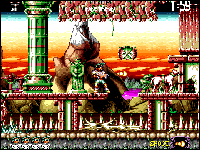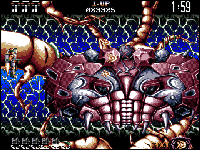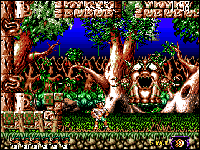 Beneath the dreadful title and
awful packaging lies a slick platform shoot-em-up. The visuals are technically
excellent, boasting wonderful parallax-scrolling. Sadly, this 3D effect is
wasted on some very 2D-looking scenery.
Beneath the dreadful title and
awful packaging lies a slick platform shoot-em-up. The visuals are technically
excellent, boasting wonderful parallax-scrolling. Sadly, this 3D effect is
wasted on some very 2D-looking scenery.

 Beneath the dreadful title and
awful packaging lies a slick platform shoot-em-up. The visuals are technically
excellent, boasting wonderful parallax-scrolling. Sadly, this 3D effect is
wasted on some very 2D-looking scenery.
Beneath the dreadful title and
awful packaging lies a slick platform shoot-em-up. The visuals are technically
excellent, boasting wonderful parallax-scrolling. Sadly, this 3D effect is
wasted on some very 2D-looking scenery.
The jump 'n' shoot action is nicely paced and unrelenting, with lots of stuff
to kill, collect and negotiate. Jimbo himself is very controllable and the only
bugbear is that he doesn't fire when he's running. With five big levels this
game deserves a look-in from all but the most fervent strategists.
Steve
Jarratt
|
|
Amiga Format Issue 37, August 1992, p.65

 Noch mal zum
Mitschreiben:
Der Ezfiesling Vulkor hat sich die Tochter des Präsidenten gekrallt und
auf einen weit, weit entfernten Planeten entführt. Und weil das für einen
Erzfiesling nicht fies genug ist, will er jetzt auch noch das Geheimnis
der ultimativen Waffe lüften, um demnächst Herrscher über die ganze Erde
zu werden. Tja, wenn einem soviel Fieses wird beschert, das ist schon
einen Superhelden wert. Bühne frei für Jim Power! Noch mal zum
Mitschreiben:
Der Ezfiesling Vulkor hat sich die Tochter des Präsidenten gekrallt und
auf einen weit, weit entfernten Planeten entführt. Und weil das für einen
Erzfiesling nicht fies genug ist, will er jetzt auch noch das Geheimnis
der ultimativen Waffe lüften, um demnächst Herrscher über die ganze Erde
zu werden. Tja, wenn einem soviel Fieses wird beschert, das ist schon
einen Superhelden wert. Bühne frei für Jim Power!
Der beschwerliche Weg in Richtung Happy-End muß unter Zeitdruck gegangen werden und führt durch fünf horizontal, gelegentlich auch vertikal scrollende Level – Onkel „Turrican" läßt grüßen. Die Wanderschaft beginnt im düsteren Wald, wo unser Held auf verschlossene Tore stößt, für die er hoffentlich zuvor die passenden Schlüssel gefunden hat. Zu den Handicaps zählen weiterhin schwebende Plattformen, auch Aliens, Drachen und große Zwischengegner trifft man in reicher Zahl. Im zweiten Level schnappt sich Jim ein Jetpack, denn auch die Gegner heben ab: Mutierte Vögel und riesige Raumschiffe sind das Kanonenfutter in der Alien-Stadt. Der Gang durch finstere Höhlengewölbe verspricht dann ebensowenig Erholung wie der Flug durch luftige Kratergefilde oder der abschließende Weg zum feindlichen Hauptquartier mit Meerblick.
Alle Sprites bewegen sich vollkommen ruckfrei und sauber animiert durch Szenarios, die prächtiger kaum sein könnten: Butterweich und parallax scrollt die herrliche Grafik in bis zu zwölf Ebenen, ohne daß der Hintergrund dabei an Farbe oder Detailreichtum einbüßen würde! Mindestens genauso schön sind die zwölf verschiedenen Musikstücke von Chris Huelsbeck, dazu gibt's kernige FX und sogar Sprachausgabe. Wäre die Spielidee also gar nicht abgedroschen, hätten wir Jim Power einen Hit wohl nicht verweigern können, so hat's halt nicht ganz gelangt. Aber ein grundsolide spielbarer Plattformausflug in gigantischer Mega-Optik ist ja auch nicht zu verachten, oder? (rl) Amiga Joker, May 1992, p.? |
| |||||||||||||||||||||||||||||

HERO QUEST
 Jim Power is a shoot 'em up along
the lines of Switchblade II and even the old fave, Kung Fu Master.
The action consists of walking across a horizontally-scrolling backdrop, and
disposing of the enemy as they appear.
Jim Power is a shoot 'em up along
the lines of Switchblade II and even the old fave, Kung Fu Master.
The action consists of walking across a horizontally-scrolling backdrop, and
disposing of the enemy as they appear.
Point, Time and Life bonuses can be
found along the way, and Jim's considerable armaments can be enhanced, too.
These bonuses are held in small pods which float in the air. When shot, they
drop both bonus points and a useful add-on, which include extra lives, smart
bombs or a shield – however, the latter is relatively useless and lasts mere
seconds before evaporating.
There are five levels to be explored, each of which is nearly fifty screens long, and involve leaping across moving platforms and ramps and overcoming other similar obstacles. Simple as this sounds, though, the sheer number of enemy sprites thrown at you make it a frustrating and thankless task.
LOOKING GOOD
On playing, it soon becomes apparent that Jim
Power plays almost as well as it looks. The joystick response to Jim is
instant, and the controls great, with a real sense of devastation available from
the game's many weapons. However, then it all begins to fall apart slightly. The
twelve layers of parallax, whilst smooth and convincing, is the first fault. The
layer you play on (the one that holds all the sprites and platforms) is actually
the second from the screen and, as a consequence, key traps can be obscured by
the foreground detail.
| LACKING SOMETHING The lack of frills in Jim Power lets the game down quite heavily. There's no high-score table and the gameplay is very run-of-the-mill. In addition, Jim's lack of jumping prowess also means that the game requires pixel-perfect positioning if you are to survive – something that is not always possible within the game's hostile environment. Jim Power looks like it could have been something really special. However, it's a very average arcade romp. I'd save my money for something a little more worthwhile – Gremlin's Switchblade II or Core Design's Wolfchild, for example. CU Amiga, July 1992, p.56 |
| ||||||||||||